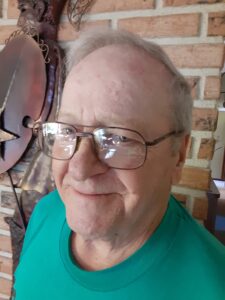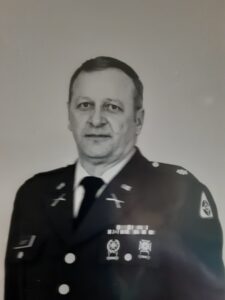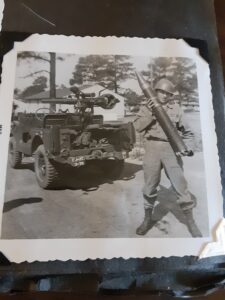by MaryAnne Block
As a child born near St. Joseph and growing up in St. Cloud, Fran Court always wanted to join the military, and when he became a young man that is exactly what he did and made a decades-long career of part-time, full-time and later retired Reserve service in the U.S. Army, all the while earning awards of distinction.
Born in St. Joseph, Court and his wife now live on his family farm just southwest of St. Joseph.
The day after graduating from high school in 1956, Court visited every recruiting office in St. Cloud. Even though it was only June 6, every recruiter told him their June quota for new enlistments had already been filled. The Army recruiter told him to try the Army Reserves because they might still have a few positions available. And thus began his career in the Army Reserves. He underwent basic training in Ft. Leonard Wood, Mo.
Because the Reserves required a person to have a full-time civilian job, Court started working at the St. Cloud Veterans Administration Hospital. After several years at the VA, he was motivated by a growing family and a desire to advance his career. So he chose to become a “tech” in the Army Reserves.
After working and training for eight years, he reached the rank of staff sergeant. He was then offered the chance to switch to full-time in the Reserves. That qualified him to become an officer, a second-lieutenant-colonel of the 409th Infantry battalion in the St. Cloud area.
“I never served overseas in war, but all those years I was training soldiers to be combat ready,” Court said. “I started with a rifle platoon of 40 people. The Korean war was done when I signed up in 1956, and that was long before Vietnam. I trained hundreds, no thousands of people in all those 37 years. When the draft ended in the early 70s, that really changed the roll of the Reserves as well.”
The Reserves are part of the federal military so they can be called into any action as determined by the president of the United States. That National Guard is a state militia, activated by the governor for crises within a particular state, such as riot control or severe weather emergencies.
When asked about what changes he had seen throughout the years of his career, he is still amazed about the modernization of equipment. He had to keep up with the advancements in equipment and tactics throughout the course of those years. To stay qualified, he received special advanced training, varying from weeks to months, in 22 different installations (military locations) throughout the United States.
Most of the time he was training Reservists at St. Cloud, but also Fort Snelling and for a short time at Fort McCoy in Wisconsin. His responsibilities included training and supervising 32 full-time staff, who then were responsible for training 750 soldiers. Court was responsible for managing and supervising six area locations (St. Cloud, Paynesville, Walker, Fergus Falls, Mora, Cambridge).
The Newsleaders asked Court to share some memories of his experiences. When he was an anti-tank platoon sergeant, he was responsible for training five companies within the platoon. He vividly remembered the anti-tank detail.
“Those anti-tank shells were large, but by no means the most advanced at the time,” he said. “Each shell was four-feet long, each weighing about 40 pounds. When fired, they could penetrate up to 22 inches of heavy steel. But we had to be careful, since the ‘back blast’ was as powerful as the forward propulsion.”
Because of the back blast, they were not used in foxhole situations because the blast would knock out the back of the foxhole and injure the four men handling the weapon. Court said the shell was usually in the back of a jeep, so soldiers could shoot and run, then move a short distance away to shoot again, if necessary. That way they avoided major damage from the back blast.
Another vivid memory was being assigned to remote Alaska for two weeks. It took six months to move all the equipment from six locations and another six months to get it all back to home base. During training, they slept in tents while the temperature hovered at minus 50 degrees. There was no wind, but tremendous cold.
“We slept 13 men to a small tent, side by side, each in a sleeping bag and then in second cold-weather sleeping bags,” Court remembered. “It was very tight quarters. A gasoline heater was our only heat source. We took turns every night sleeping close to the heater. Whoever was closest was responsible to turn it off last thing at night and to get it heating the next morning. We would all rotate who would be closest to the heat, and the next night move one space farther away from the heat. When I got back home to my wife, Marilyn, and the kids, I told her I felt I could do anything after that.”
Court recalled one day touring inside a nuclear submarine dubbed the “Minneapolis/St Paul” in Norfolk, Va. During the tour, Court learned at that time sleeping space was at a premium, requiring soldiers sleep either on their stomachs or on their backs. There was no height to turn over, so if someone wanted to change position from front to back, he’d have to slither out, turn around and get into bed in the new position.
“During preparations for Desert Storm I was in Norfolk,” Court said. “The mammoth C-5A aircraft were huge but could only transport two of the big tanks at a time. A jet took off literally every 10 minutes around the clock, getting military equipment to the desert in preparation for the Desert Storm invasion. My sleeping quarters were only a quarter mile from the air strip, so I never did get any quality sleep during that training mission.”
Court is especially proud of his involvement as an Army Reserve on the site-selection committee for the new Army Reserve training center. The selection committee found 13 possible St. Cloud area sites to consider. The Corps of Engineers evaluated the sites and chose the St. Joseph site. The Corps did all the construction.
During those 38 years of Reserve service, he and Marilyn, who also grew up in the St. Joseph area, raised six children. At first, they lived in St. Cloud. Eleven years later they moved to the homestead that his grandfather had settled. There they built additions to the farmstead, where they still live. Both agree being on the farm was a terrific place to raise the kids, especially the two youngest sons.
Court retired at age 65 as a lieutenant-colonel 05, which is a higher rank than a captain or even a major. After retirement, he knew officers could be recalled for active duty until age 70. He could have been called to be in Desert Storm, and he even volunteered but did not receive notice. His St. Cloud 409th Infantry Battalion was activated and fought at that time.
During the years Court has been active in many area organizations, including the Lions Club, the American Legion, bowling league, softball league (until age 68), the St. Joseph Chamber of Commerce, Knights of Columbus, and the St. Joseph Rod and Gun Club, plus many others.
Now 85, Court has been married to Marilyn for 64 years. He is an active member of the American Legion of St. Joseph for 42 years, currently serving as historian and photographer.

Fran Court still enjoys living on ancestral homestead farm property just southwest of St. Joseph. He and his wife, Marilyn, raised a large family on that property.

Fran Court many years ago in his military uniform.

In a photo taken decades ago, Fran Court holds a combat shell that could be extremely dangerous to those who fired it.




